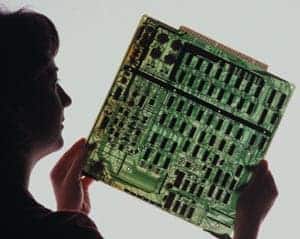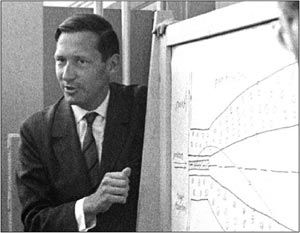Physicists must learn to collaborate with engineers, rather than look down their noses at them, says Julian White

Physicists have always seen themselves as being one (maybe two) steps removed from the mundane job of translating their work into practical benefits for the good of everybody, including themselves. That is the job of engineers, who are often viewed as technicians to be called upon when needed and shooed away when not.
Surprisingly, though, some of the most beautiful results in physics have been obtained by engineers. Simon van der Meer, for example, shared the 1984 Nobel Prize for Physics with Carlo Rubbia for the discovery of the W± and Z0 particles at CERN thanks to his invention of “stochastic cooling”, which reduces the energy spread of a bunch of particles travelling in an accelerator ring. However, van der Meer does not see himself as a great scientist – just an engineer who likes to get on with inventing and building nice machines.
The point is that if physicists want to discover new horizons, they need engineers – those masters of practicality – to achieve new results. Even I have been guilty of ignoring engineering. As a PhD student it was almost a competition in our lab to see who could achieve results with the most Heath-Robinson-like equipment.
By focusing on function, rather than form, niggling problems cropped up as I gave too little thought to fastening, electrical contacts, the differential expansion of materials and so on. All these problems could have been solved overnight if only I had thought more like an engineer. Doing so would probably have let me produce more and better data in a shorter time.
Artificial divisions
One reason why physicists look down on engineers is that their two disciplines are often artificially divided. In most universities, for example, the physics and engineering departments are usually physically far apart, which is both odd and silly, as each discipline has complementary knowledge and skills. In fact, physicists suffer more than engineers from this estrangement.
Take IBM, which in the late 1970s embarked on a long and expensive project to create superconducting mainframe computers using “Josephson junctions”. Physicists in the company had argued that these junctions consumed significantly less power than the competing silicon technology of the time and, moreover, could be switched in less than 5 ns.
However, the project eventually ran into the buffers because it simply proved too difficult to reliably fabricate the necessary lead-lead-oxide junctions and too expensive to cool the machine to superconducting temperatures. Of course, the project also failed because of the ongoing improvement in silicon microelectronics.
Undaunted, in the 1980s the electronics industry turned to gallium arsenide as a possible replacement for silicon in certain applications. But standard silicon-based microelectronics has continued to get better and, two decades later, gallium arsenide has been edged out of contention even in these specialized areas.
This quite staggering improvement in performance has been brought about by engineers tweaking and tinkering with silicon on a daily basis over two decades. With Moore’s law still apparently alive and well, any new material will find it increasingly difficult to displace the incumbent silicon. Indeed, I fear that the latest pretenders to silicon’s crown – materials such as plastics, carbon nanotubes and buckyballs – will ultimately suffer the same fate.
Energy blues
Another field where engineers will win the day is energy. But in trying to solve the energy crisis what do physicists do? They think big and start a decades-long project that seeks to harness the power of the Sun in a big shed. But despite the billions of dollars so far spent, not a single joule of useful electricity has been produced from such experiments.
Engineers, meanwhile, have been doing more mundane – but much more useful – things. They have increased the efficiency of generators and transmission systems, and are now poised to exploit new sources of energy such as wind, tidal and photovoltaic. To be fair, physicists have often helped with this work, but it is largely driven by engineers.
More energy has probably been generated by wind turbines than by the combined man-made fusion reactions, and this will continue to be the case for a very long time. Even the €10bn International Thermonuclear Experimental Reactor (ITER), which is soon to be built in France, is only the next step on the road to a practical fusion reactor operating in 2050. Of course, as a means of stimulating international scientific collaboration and doing large-scale plasma physics, the project’s value is unquestionable. But in terms of providing a practical route to replacing coal and nuclear power stations, it is almost irrelevant. Physicists are going to have to realize that governments and the public may ultimately feel misled by the spin that physicists are giving to fusion.
More interaction needed
In both these examples, physicists underestimated and understated the sheer size of the task and the practicalities involved. In large part this has either led to outright failure or telescoping timescales, which is failure in disguise. The danger is that industry and government will see that physicists and physics-based solutions are unable to come up with the goods, while other people – mostly engineers – are getting on and solving the problem in less ambitious, but more productive, ways.
Physicists are doing themselves a disservice by not managing this process better. Ultimately, it is they who are compromised as the world not only stops believing what they say, but actually does not even bother to listen as physicists seem unable or unwilling to solve the problem at hand.
What we need is much more interaction between physics and engineering, and it is probably fair to say that physicists should make the effort. Secondly, there should be more emphasis on combining the two disciplines at an early stage; for example by making undergraduate physicists do a detailed term-long design project. Finally, physicists should begin to think like engineers and become more interested in the nuts and bolts of the problem.
Who knows, rather than being a burden, such knowledge may lead to a new level of sophistication in the way physics is done.
Engineers versus physicists
We have all heard the joke about the engineer and the physicist who are asked to build a chicken coop for a farmer. (The physicist begins with the line, “First assume a spherical chicken in a vacuum…”) But what really is the difference between physics and engineering?
Physics, by its very nature, is about probing the limits of material systems and trying to uncover new facts about the way things behave. Engineering, in contrast, is about taking elements that tend to be already known and reshaping them in some way — either to make improvements to existing systems or to create some new solution to a problem.
Maybe the difficulty for physicists is that when confronted with a problem, we are simply too keen to adopt a solution that is far too radical and has a greater tendency to fail. When those solutions do then fail, we justify having used them by saying that only a radical solution would have solved the perceived gap in performance.
Engineers, in contrast, prefer to improve processes in an incremental way. Over time, this can lead to staggering improvements, provided sufficient time and resources are available. Without doubt both approaches have their merits in different circumstances, but physicists would do well to appreciate how engineers think.




